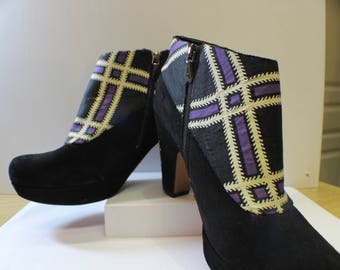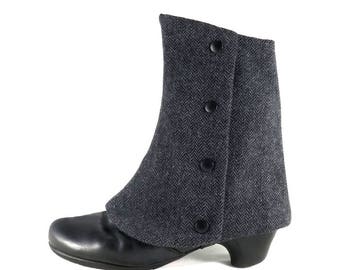

To complete the princess costume, you would need a knee length gown, white elbow gloves, and a tiara for the hair. These boots are also ideal for a childrens princess costume. The boots can be decorated with gold buttons to add to the effect. There are many styles of steampunk costumes, but these boots will look good to a high low style dress, a top hat, and steampunk goggles. These boots are a great costume accessory for a steampunk costume. Wear them to scanty tops and barely there pants to complete the look.
WHITE BOOT SPATS MOD
These mod 1960s style costume boots are the ideal rave costume shoes. They will fit most any adult and youth but may be a little big on children. These are great for a 60s 70s or 80s style cheerleader, dancer, or diva queen. It will fit woman and child and add a little hippy spice to the clothes you are Tall Cloth Boot Shoe Cover is the ideal boot for any size calf.
WHITE BOOT SPATS MOVIE
White or gray spats became almost as identified with the gangster as his machine gun, and many men copied the style of the gangsters and the movie stars who played gangsters.īy the mid-1940s spats had, for the most part, disappeared from the fashion scene, replaced by rubber galoshes, which did a much better job of keeping feet warm and dry.

The clothes worn by gangsters influenced fashions in the United States and Europe from the 1920s through the 1940s. Gangsters were often wealthy and dressed in expensive, stylish, and flamboyant clothes. This caused a tremendous rise in the illegal manufacture and sale of alcohol, and the rise of the gangster, a member of a gang of criminals. In January 1920 a law was passed forbidding the sale of alcoholic beverages. Spats became a part of gangsters' wardrobes during the 1920s. Many men wore spats with a tailored vest, which became known as the Boulevard Style. A line of pearl buttons often fastened the spats at the side. The new spats were made in the era's fashionable colors, which had names like dove (gray) and biscuit (off-white), and were made of heavy canvas in the winter and linen in the summer. The wardrobe of the well-to-do male, giving a "boot look" to shoes. However, by 1910 shoes were back in style for men, and a kind of shortened spat became a required part of

During the early part of the 1900s men wore them less frequently, as boots had come into fashion. Spatterdash, or spats, as they came to be called, remained popular for both men and women for several centuries. Gaiters were also called spatterdash because they protected their wearer from spatters and dashes of muddy water in the street. By the 1700s several European nations had made gaiters a part of their military uniform. They were worn by both women, whose dresses did little to protect shoes and stockings from mud and water splashes, and men, who at that time wore breeches, a type of pants, that ended just below the knee. Gaiters were leggings that covered the shoe and leg up to the knee. Spats originated in the seventeenth century as leather or cloth coverings called gaiters. However, between 1910 and the mid-1930s, spats eventually became an elegant men's fashion accessory, often associated with gangsters and dandies, a term to describe well-dressed men of the time.

They were first designed to protect shoes and ankles from mud and water while walking. Spats are linen or canvas shoe coverings that fasten under the bottom of the shoe and button up the side.


 0 kommentar(er)
0 kommentar(er)
